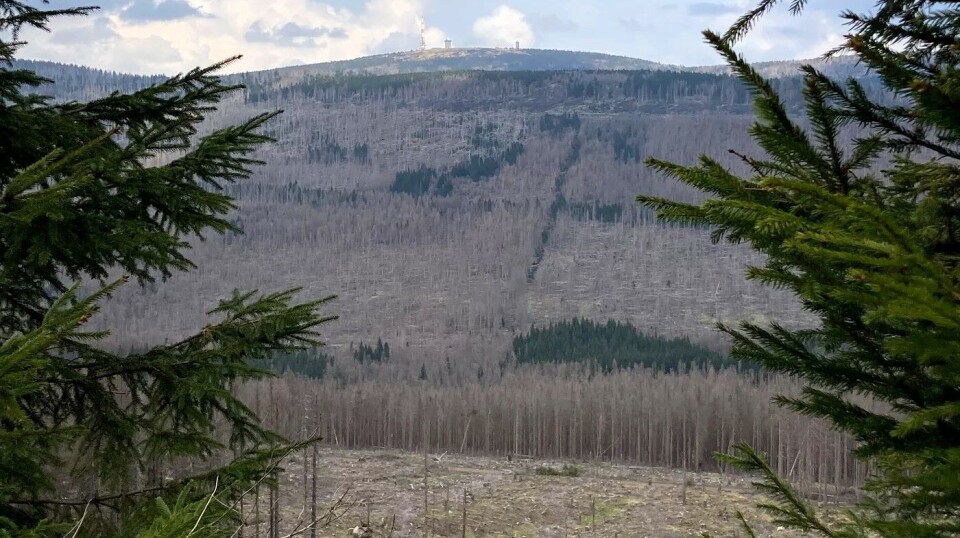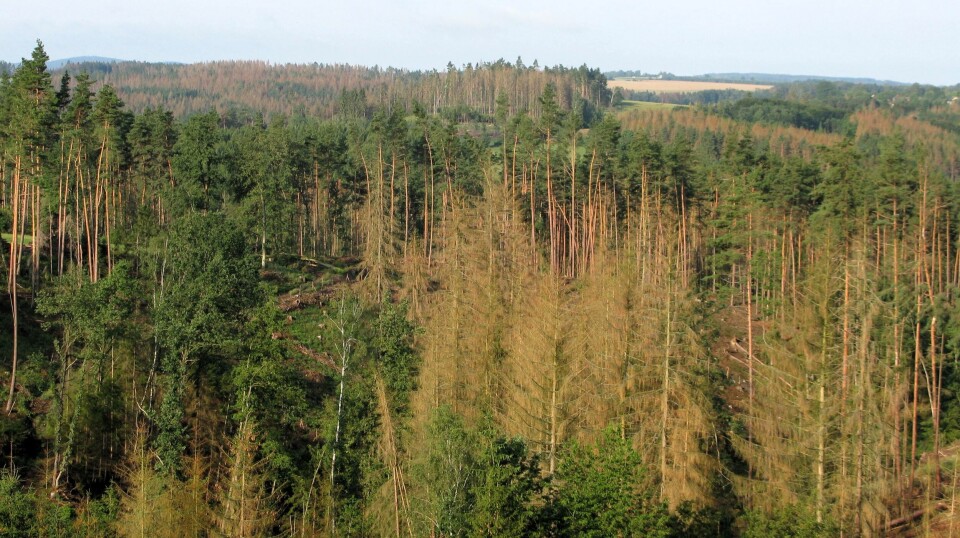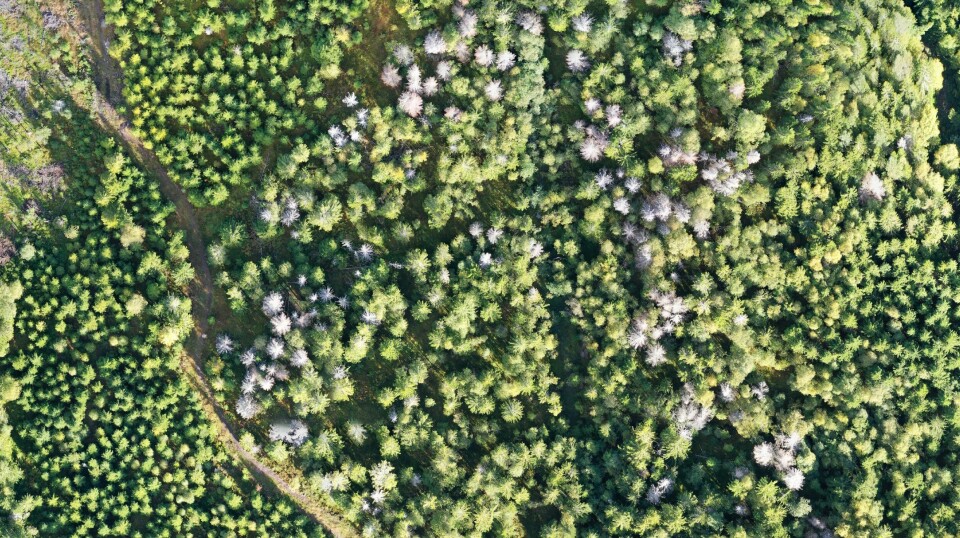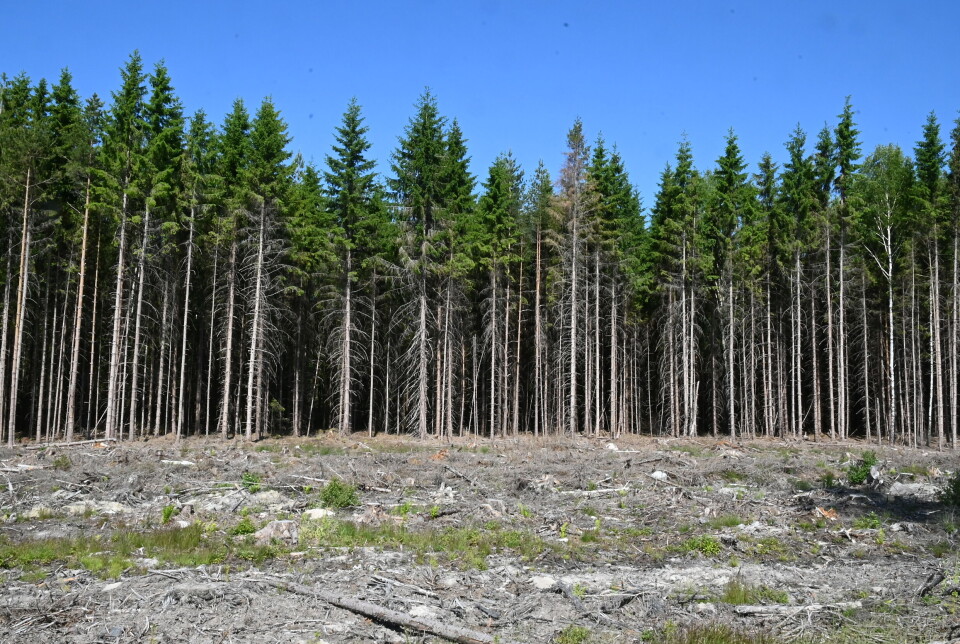THIS CONTENT IS BROUGHT TO YOU BY NIBIO - Norwegian Institute of Bioeconomy Research - read more

Increased risk of major bark beetle outbreaks – also in Norway
Fewer spruce trees and softer clearcut edges can prevent and mitigate future bark beetle outbreaks.
Ecosystems worldwide are threatened by climate change – and this is especially true for the vast areas of coniferous forests in the northern hemisphere.
Spruce forests represent as much as a quarter of Europe's productive forests and 45 percent of the northern, boreal forests. Productive forests refer to forests where logging can be economically profitable.
These forests are important for biodiversity, carbon storage, and raw materials for industry.

The last years, however, the spruce forests in southern Sweden and Central Europe have experienced catastrophic bark beetle outbreaks. Areas with much planted spruce are particularly hard hit by the ravages of the European spruce bark beetle.
In just one year, 118 million cubic metres of spruce were killed by the spruce bark beetle. This is ten times more than Norway's annual logging. The attack was triggered by the extreme drought summer of 2018.
In addition to damaging timber production, bark beetle attacks also reduce the forest's CO2 uptake.
When many trees die, it can lead to more flooding, erosion, and an altered nitrogen balance in soil and streams. In the Czech Republic, several water treatment plants are experiencing problems because the forests, which previously helped purify the water, are gone.
From harmless to aggressive
The European spruce bark beetle usually does not attack healthy trees. Most of the time, it lays eggs and reproduces in dying spruce trees or fresh timber.
However, when the beetles become numerous - or the trees are weakened by drought or wind – the system reaches a tipping point where the bark beetle changes behaviour. It goes from relatively harmless to aggressive and begins to attack healthy trees.

The first beetles to attack a tree attract other spruce bark beetles using chemical signals, called pheromones. This behaviour can lead to colossal outbreaks, where hundreds of thousands of trees are killed.
Norway has not experienced a major bark beetle outbreak since the 1970s, but there is growing concern - both among researchers and forest managers - about new outbreaks as the climate warms.
The calm before the storm?
NIBIO researcher Jostein Gohli is studying fluctuations in spruce bark beetle populations. He says we now may be experiencing 'the calm before the storm' in Norwegian forests.
“The European spruce bark beetle is probably the most destructive insect species in Europe's forests today. It's an aggressive tree killer that attacks spruce-dominated forests in outbreaks that can last for several years," he says.
As climate change accelerates, the large spruce forests in northern Europe may also face devastating bark beetle outbreaks.
Together with colleagues at NIBIO, Gohli recently published a scientific article identifying factors that increase the abundance of spruce bark beetles.
The study was based on 17 years of bark beetle trap data from a period without outbreaks, information from the forest resource map SR16, and climate data.

The results show that drought, higher temperatures, the amount of spruce forest, and clearcut edges were the most important factors. The trees left along the edge of a clearcut are likely vulnerable to beetle attacks because they are weakened by sudden exposure to sun and wind.
“The spruce bark beetle usually does not attack healthy trees but will do so when they become numerous enough. The more bark beetles in the landscape, the greater is the chance that they will kill healthy trees and start year-long outbreaks,” says Gohli.
Both the amount of spruce forest and the shape and size of clearcuts can be influenced by changed forest management. Gohli points out that such changes can be crucial to create more robust spruce forests that can cope with climate change.
Living with bark beetles
Insect attacks can contribute to more varied forests, provide more light, and more dead wood - which is important for biodiversity. The gaps that are created in the forest canopy also provide opportunities for new trees to grow in the place of fallen giants.
However, the enormous scale of the ongoing bark beetle attacks in Central Europe is causing forest researchers to raise alarm bells.
“Many still talk about the need for even more forestry in the same form as today. The truth is that even Norway's boreal forests probably must be geared towards increased stability to avoid enormous future losses of CO2, biodiversity, and money,” Bjørn Økland says.
He is an insect expert and senior researcher at NIBIO.
“Other research from NIBIO shows that there is already an increase in CO2 emissions as a result of damaged, weakened, and dead trees in Norwegian forests,” he says.
‘Sprucification’ of Europe's forests has benefited the beetles
So, what should a forest owner do?
“Specifically, we recommend planting less spruce in vulnerable areas, and focusing more on mixing in other tree species, such as pine and deciduous trees,” says Jostein Gohli.
“Locally, drought-prone areas are problematic for spruce. But, by vulnerable areas, we also mean the southern parts of Eastern Norway. Here, there are large volumes of spruce that will encounter climate warming early,” he adds.
Gohli points out that there is now more than twice as much spruce in Norwegian forests as there was 60 years ago. In 1960, there were around 200 million cubic metres of spruce. It is now approaching half a billion cubic metres.
More spruce forests have also been the trend in many other countries, but further south in Europe, forest owners are now reducing the amount of spruce as a result of the bark beetle attacks.
In areas of the Czech Republic where the spruce forest has been wiped out, research on which other tree species can be used to establish new forests is now underway.
Clearcut edges are important for beetle reproduction
Gohli explains that an alternative to today's clearcutting is more closed logging forms, where the clearcut areas are small or more trees of varying heights are left, so that the edge zones are not so sharp. Such logging forms are referred to collectively as continuous cover forestry.
“But closed logging is not suitable everywhere and can also lead to other problems, such as more root rot,” he says.

“Continuing with volume-dense monocultures of spruce is a strategy that can yield high returns, but it also entails a high risk of extensive bark beetle damage and economic losses in the long run,” he says.
To achieve forests that are more resilient to climate change and bark beetles, researchers propose changing the forest structure - that is, the age and species distribution of the forest.
“Natural forests, and other forests that have not yet been clearcut, typically have a favourable structure. If we replace such forests with single-species spruce plantations, we might facilitate more bark beetle problems in the future,” says Gohli.
It will necessarily take time to change today's monocultures of spruce and establish a more multi-layered, multi-species forest.
“Given that it takes decades from planting to harvesting, we should start to change our forests as soon as possible. Not least because the forests we plant today will grow up and become harvestable in a climate that probably will be completely different from today’s,” Gohli concludes.
Reference:
Gohli et al. Climatic and management-related drivers of endemic European spruce bark beetle populations in boreal forests, Journal of Applied Ecology, 2024. DOI: 10.1111/1365-2664.14606

This content is paid for and presented by NIBIO - Norwegian Institute of Bioeconomy Research
This content is created by NIBIO's communication staff, who use this platform to communicate science and share results from research with the public. NIBIO is one of more than 80 owners of ScienceNorway.no. Read more here.
More content from NIBIO:
-
This colourful bird is thriving in Norway
-
Can drone-mounted tree planting replace manual tree planting?
-
Light traps can tell us more about nocturnal moths
-
Climate change and land use threaten Sámi reindeer husbandry
-
Researchers are now going to monitor carbon in forest and grassland soils
-
Nine facts about Norwegian agriculture




































